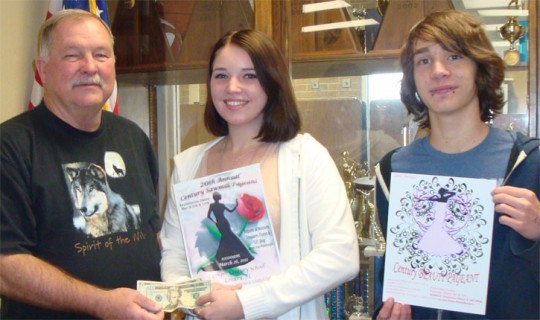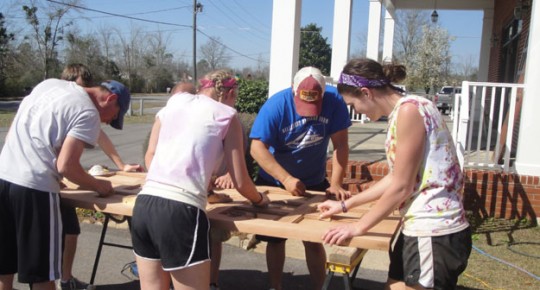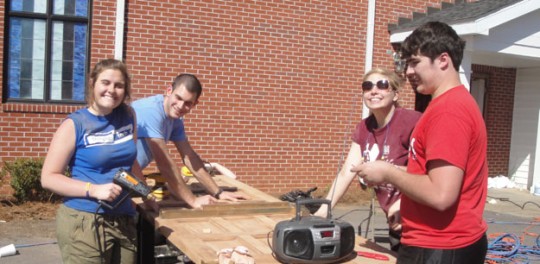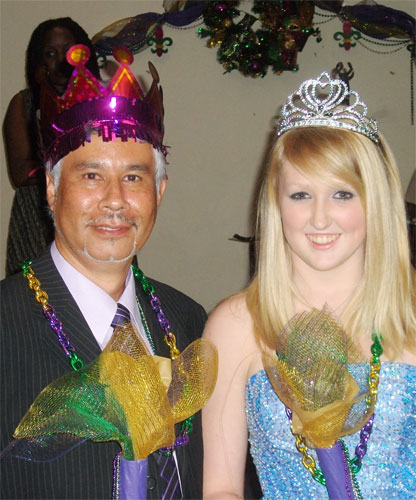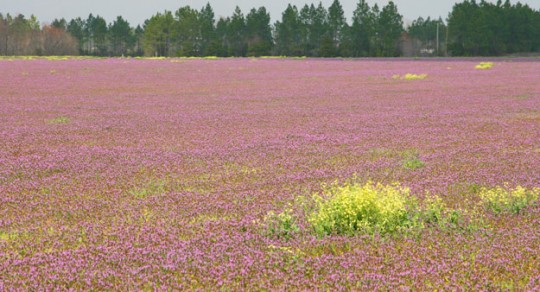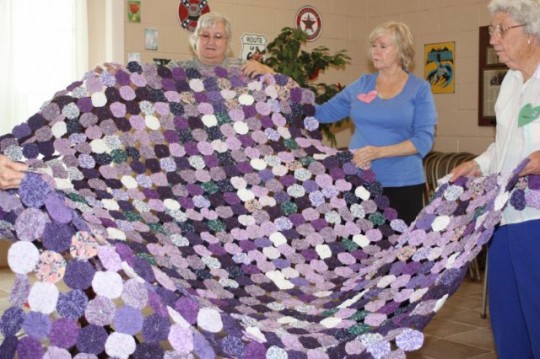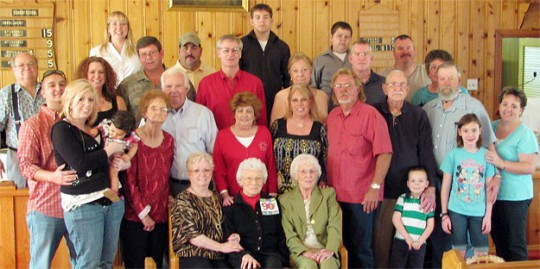Sherrill Named To Dean’s List
March 6, 2011
 Kate Elizabeth Sherrill was recently named to the Dean’s List at Berry College for the fall semester.
Kate Elizabeth Sherrill was recently named to the Dean’s List at Berry College for the fall semester.
Sherill is a junior majoring in vocal performance with a minor in theater. She is a member of the Berry Singers and the Berry Concert Choir. Sherill recently appeared in Berry’s production of Hecuba and was invited to participate in the Irene Ryan scholarship program for her role as Rhonda in Almost, Maine.
Sherrill is the daughter of Kent and Anne Sherrill of Walnut Hill and the granddaughter of Dean Graham and the late Sam Graham and the late Hunk and Senie Sherrill, all of Atmore.
Jay, Northview Students Create Sawmill Pageant Posters
March 3, 2011
Students from Northview and Jay high schools were recently awarded for taking part in a poster contest to promote the 20th Annual Century Sawmill Pageant sponsored by the Century Lions Club.
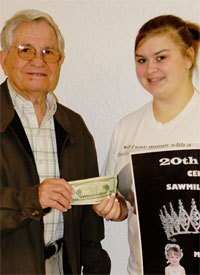 Winners from the Northview High School Business Technology Education Department were Rebecca Barnhill, first place; A.J. Lambert, second place; and Ashley Digmon, third place. Barnhill received a $25 prize.
Winners from the Northview High School Business Technology Education Department were Rebecca Barnhill, first place; A.J. Lambert, second place; and Ashley Digmon, third place. Barnhill received a $25 prize.
Winners from the Jay High School Commercial Graphic Arts classes were Haley Odom, first place; Damian Rogers, runner-up. Odom received a $25 prize.
The 20th Annual Century Sawmill Pageant sponsored by the Century Lions Club will be held Saturday, March 26 at 10 a.m. at the former Carver/Century School. Registration will be held Saturday, March 5 and March 12 from 10 a.m. until 5 p.m. at Southern Treasures Gift Shop at 8341 North Century Boulevard (across from Whataburger). For an entry form and more registration details, click here.
Pictured: 20th Annual Century Sawmill Pageant poster contest winners. Top: From Northview High — Rebecca Barnhill, first place; A.J. Lambert, second place; and Ashley Digmon, third place. Barnhill received a $25 prize. Bottom: From Jay High — Century Lions Club member Bill Gandy, Haley Odom, first place; Damian Rogers, runner-up. Pictured inset: Northview’s winner Rebecca Barnhill receives her $25 prize from Century Lions Club member Edsol Smith. Submitted photos for NorthEscambia.com, click to enlarge.
Louisiana College Students Use Spring Break To Help Molino Church
March 2, 2011
A group of Louisiana college students used their spring break to help a Molino church.
About 40 college ministry members of Temple Baptist Church in Ruston, Louisiana, actually paid $100 each for the opportunity to travel to Molino and work around the campus of Highland Baptist Church. From painting, to replacing a rotten bathroom subfloor under a toilet, to creating a classroom for a new Sunday School group, to landscaping and a lot of energy efficient lighting upgrades, the students performed numerous tasks for the church.
“We feel like our spring break is better spent if we help others instead of if we just sit around and do nothing,” Louisiana Tech student David Hinds said. “It’s better to serve others.”
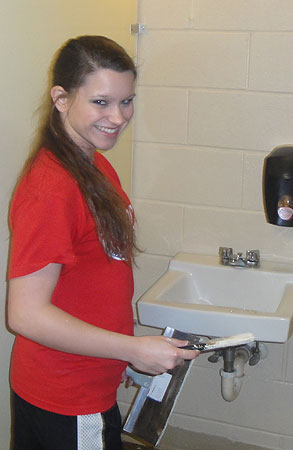 For the past eight years, the 1,000-member Louisiana church has sent spring breakers to places like Miami, Seattle and San Diego to serve. The Molino visit became a reality because of a friendship between Highland Baptist Pastor Brian Calhoun and a minister at Temple Baptist.
For the past eight years, the 1,000-member Louisiana church has sent spring breakers to places like Miami, Seattle and San Diego to serve. The Molino visit became a reality because of a friendship between Highland Baptist Pastor Brian Calhoun and a minister at Temple Baptist.
A project list was created and supplies were purchased prior to the students’ arrival. They worked Friday, Saturday and Monday at Highland. And yes, they did manage a brief two hour trip to the beach between Sunday church services — but they were hard at work ministering while they were there.
“We try to use our spring break to help others to further the Kingdom in whatever we do,” Hinds said.
“It was just a labor of love. We didn’t deserve this; it was selfless sacrifice,” Calhoun said. “It reminds me of the selfless sacrifice of Jesus.”
Tuesday, the students that worked at Highland joined about 20 other Temple Baptist members at the University of West Florida to cook lunch for about 350 UWF students before heading back to Louisiana for class.
Photo Gallery: Relay For Life Mardi Gras Masquerade
March 2, 2011
A Mardi Gras King and Queen were named in Century last Saturday night as over $900 was raised in a silent auction to benefit the American Cancer Society’s Relay for Life.
Cesar Gonzalez and Lauryn Walker were crowned Century’s King and Queen of Mardi Gras in recognition of raising the most money during the Relay Mardi Gras Masquerade. The event also included entertainment from the Will Inspire band (complete with a conga line), gumbo, red beans and rice and the quintessential Mardi Gras dessert –moon pies.
For more photos from the event, click here.
Pictured: Century’s Mardi Gras Masquerade King Cesar Gonzalez and Queen Lauryn Walker. Submitted photos for NorthEscambia.com, click to enlarge.
Sea Of Purple: What’s That Purple Flower That’s Everywhere Called?
March 2, 2011
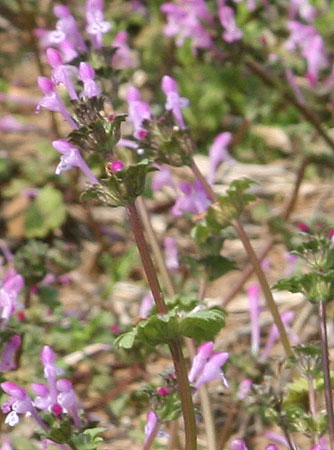 Ever wonder what the name of that that purple flower is that is blooming everywhere in North Escambia, often turning entire fields (or the corner of a neighborhood yard) into a sea of purple?
Ever wonder what the name of that that purple flower is that is blooming everywhere in North Escambia, often turning entire fields (or the corner of a neighborhood yard) into a sea of purple?
We posed the question to UF IFAS Escambia County Extension Agent Libbie Johnson and found out it’s called henbit (or more scientifically, Lamium amplexicaule):
Henbit is a cool season, annual broadleaf weed that germinates in the fall and continues to grow throughout the winter and spring. In some of Escambia County’s agricultural fields, it is currently one of the dominant species present.
Henbit is a member of the mint family. If you take a good look at it, you can see that it has square, slender stems. The stems can root at the lower nodes. Leaves are opposite, nearly circular, deeply veined, hairy and petioled. This isn’t a deeply rooted plant—roots are shallow and fibrous. The tubular flowers are generally purple to pink in color.
“Like most plants, the best control is achieved before the plants start to flower. Herbicides work better if you can spray when the plants are small and immature, but with the cold winter, scouting planted pasture for weeds may not have been on the top of the list of activities. For many, no control of henbit is necessary. Contact your local Extension agent to determine which herbicide would work best for your particular cropping system,” Johnson said.
Pictured: A sea of purple is formed by henbit in a field along Highway 97 at Tungoil Road in Walnut Hill.
Escambia Students Of The Month Named
March 1, 2011
Escambia County Students of the Month for February have been named by the Escambia Association for Administrators in Education. The awards are presented monthly to two students from participating schools.
The following students were named from participating North Escambia area schools:
- Bratt Elementary — Hunter E. Carter, fifth grade; Jonathan T. Gibbs, first grade
- Jim Allen Elementary — Anthony R. Leger, kindergarten; Kornesha S. Purifoy, kindergarten
- McArthur Elementary — Jesse C. Kintz, kindergarten; Alejandra E. Martinez, kindergarten
- Molino Park Elementary — Ariel S. Ward, second grade; Kenley E. Brown, second grade
- Ransom Middle — Cortez M. Jackson, seventh grade; Angel J. Chu, seventh grade
- Northview High — Elizabeth A. Wright, 11th grade; Joshua M. King, 12th grade
Pictured top: Northview High School Students of the Month for February Joshua M. King and Elizabeth A. Wright. Submitted photo for NorthEscambia.com, click to enlarge.
NJROTC Places In Multi-State Drill Meet
February 28, 2011
Northview High School’s NJROTC recently participated in a drill meet at Southern University in Baton Rouge, Louisiana.
The unit competed in multiple events which included a personnel inspection, academic test, basic and exhibition drill and physical fitness. Out of 16 schools from Florida, Mississippi, Alabama and Louisiana that competed in the meet, Northview finished fifth overall. The unit was third in the personnel inspection, fifth in the armed exhibition drill and sit-ups and sixth in unarmed and armed basic drill.
“Performance by the unit was excellent and was the culmination of a lot of hard work over the past several weeks by each cadet that competed. They represented Northview and the community in an outstanding fashion,” said Capt. Charlie Code, instructor.
Pictured: The Northview High School NJROTC participated in a drill meet at Southern University in Baton Rouge, Louisiana. Submitted photos for NorthEscambia.com, click to enlarge.
Molino Homemakers Make Yo-Yo Creations
February 27, 2011
 The Molino Homemakers met on February the 2nd. A program was given by Ruth Miller on making Yo-yo’s. Pressed material was cut into circles by Becky Dorch on her cutting machine.
The Molino Homemakers met on February the 2nd. A program was given by Ruth Miller on making Yo-yo’s. Pressed material was cut into circles by Becky Dorch on her cutting machine.
Circles were then hand sewn around the outside edge and the thread pulled tightly to make the yo-yo come together in the middle. After several yo-yo’s are made they can be stitched together to make many projects.
 Some of those projects include quilts, wreaths, appliqués, pillows, bunnies and clowns. The possibilities are endless.
Some of those projects include quilts, wreaths, appliqués, pillows, bunnies and clowns. The possibilities are endless.
The Molino Homemakers share ideas and skills passed down to them to assure its continuation into the next generation of Homemakers. We never forget the knowledge and wisdom that sits amongst us each meeting.
The next club meeting will be on Wednesday March 2, 2011 at Aldersgate United Methodist Church at 10 a.m. Dues are $5 per year. Visitors are welcome.
Submitted photos by Terri Brown for NorthEscambia.com, click to enlarge.
Featured Wee Recipe: Southwestern Chicken Tortilla Soup
February 27, 2011
This weekend’s featured recipe from Janet Tharpe is a Chicken Tortilla Soup. Thick and hearty, this soup is packed with Southwestern flavor.
To print today’s “Just a Pinch” recipe column, you can click the image below to load a printable pdf with a recipe card.
Hazel Bolen Celebrates 90th
February 27, 2011
 Byrneville resident Hazel Bolen celebrated her 90th birthday last week.
Byrneville resident Hazel Bolen celebrated her 90th birthday last week.
The Women’s Ministry at Byrneville United Methodist Church gathered friends and family for a celebration last Sunday, with a big surprise. She was able to hold her great-great granddaughter Taylor for the first time as great-grandson Josh Mixon was able to attend the party from out of town — make five generations at the event.
Hazel has two sons, Wilbur and Wayne Levins, as well as many grandchildren.
Pictured top: Family and friends gather to celebrate Hazel Bolen’s 90th birthday at Byrneville United Methodist Church. Pictured inset: Hazel is able to hold Taylor Mixon, a fifth generation family member, for the first time. Submitted photos for NorthEscambia.com, click to enlarge.



